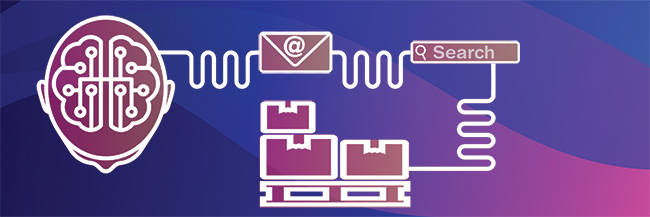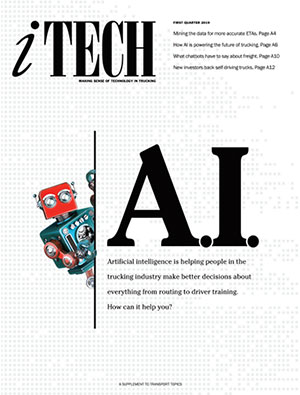Artificial Intelligence: A New Look for Business Productivity Tools
While artificial intelligence is increasingly being applied on a massive scale to alter the very nature of how the world works, it turns out AI is also very good at making everyday drudgery disappear. Productivity apps powered by AI are emerging that will help you, for example, come up with snappier and more personalized e-mails, transcribe all your phone calls into searchable text or find just the right photo that goes with the color scheme you’re using for your presentation.
And while most of us are well acquainted with everyday apps designed to help us work more efficiently, the best of the new incarnations powered by AI have been programmed to learn over time and become ever-smarter at the everyday tasks they’re handling for you.

Dysart
The latest search tool for Microsoft Office, for example, goes far beyond searching for things that you’re looking for and actually gets to know how you work. The idea: The better the program “knows” you, the better search results it can bring back to you.
“AI is not some next-generation technology that will be available in 20 years. It’s being used now, across our economy, and the potential economic benefit for fleet operators is immense,” said Hoyoung Pak, head of transportation, logistics and supply chain at Uptake, an AI transportation software firm.
John Reed, chief information officer at Aim NationaLease, added: “Like most disruptive technologies, there is an enormous upside potential to AI when properly used.”
As time goes on, some trucking executives envision an expanding role for AI within the transportation industry.
Sarah Riggs Amico, executive chairwoman at Jack Cooper, said: “Eventually, I suspect AI will be used to manage the efficiency of the entire supply chain in our industry — including the use of deep neural networks and predictive analytics to prepare for likely weather events or traffic disruptions, for example.”

Scott Sullivan, CFO and chief information officer at Pitt Ohio, yearns for the day — which is being promised by AI technologists — that AI is infused into every aspect of logistics planning, particularly in the less-than-truckload sector.
“Can you imagine — if you can ‘AI’ the whole LTL process based on history — how you can drive efficiency into the customer experience and the process?”
Brian Wood, director for enterprise technology services at Ryder System Inc., has similar hopes: “I’m looking forward to when the systems we support, as well as the trucks and smart warehouse systems, are calling me to tell me there’s something I should be aware of. This is already happening with real-time route optimization and monitoring.”
Even today, scores of productivity tools currently are being completely remade by AI.

Read more iTech stories:
It’s a great time to take a look at what’s out there, and where the software category is headed.
Here’s a representative sampling:
• Personalize Your E-mails With an AI Web Crawler: Aizimov adds a personal touch to your e-mails by auto-crawling the web for interesting insights on the people you do business with.
“All you have to put in are four things: first name, last name, e-mail and company,” said Jerome Devosse, Aizimov’s CEO. After that, the software searches Facebook, Twitter, LinkedIn and other social networks for insights about your contacts, including their likes, dislikes and passions.
“If the guy, for example, has done a marathon, I may finish the e-mail by saying, ‘By the way, I also did a marathon in Rome, here’s my time — how do we compare?’ to get their attention,” Devosse said.
Aizimov also works for you after you send your e-mail, collecting info on the types of e-mails you send that get the best responses, based on tone, length, content and time-of-day sent.
Using these insights, it will put together a draft of an e-mail the next time you want to communicate with your marathon buddy — which you can use as is or customize to your own tastes.
• Leverage Microsoft Office’s New AI: Stop one for millions of computer users each day, Microsoft Office has been given an AI face-lift. It will now automatically transcribe your conference calls into text and even organize that text with automatic subtitles.
Joe White, owner of CostDown Consulting, sees calls-to-text as a natural for trucking.
“Transcribing phone calls to searchable text would provide an excellent tool for researching recruiting calls,” White said. “From driver conversations, we could identify, quantify and rank their ‘must-have’ job influences by the questions they ask. The top influences could then be used to adjust and improve a company’s employment offering. From recruiter conversations, we could analyze how effectively they communicate their company’s employment offering and what additional training they may need.”
PowerPoint users will also appreciate the new AI version of the program, which can automatically create a presentation after you type a line or two of text over each slide you plan to use.
And Office search is now completely powered by AI. Cortana, an AI assistant that made its debut in Microsoft Windows 10, also has been integrated into Microsoft Office.
• Transcribe Your Phone Conversations: Tetra uses AI to translate any conversation you have into searchable text. Almost immediately after you finish a phone call using Tetra, you’ll receive a detailed text synopsis of the conversation in your inbox — searchable by keyword.
All of Tetra’s transcripts also include two-way speaker ID, so you’ll always know by looking at the text who said what.
Eva, Voicera’s AI assistant, is another app in this genre that’s also worth checking out.
• Send Out for an AI Rewrite: If you’re looking for a different take on some text you’ve just written, SpinnerChief will rework it for you so you can present it from a slightly different perspective. The software has also been designed to ensure the text it produces is optimized for the search engines.
Another AI program in the same genre is Writer. Writer is designed to learn everything you need to know about a specific topic by crawling the web and then presenting the results to you in a text article. The program works best when you instruct it to research an extremely narrow topic.
• Index Your Photo Library With AI: Imagga is able to analyze your entire photo library, studying one picture at a time at blazingly fast speed and then tagging each image so you’ll be able to quickly call up any image with a text search.
• Find Images for Your Color Theme: Everypixel bests the other stock images libraries on the web by offering you the ability to find an image based on the color scheme you’re using for your ad or presentation.
• Add an AI Tax Adviser to Your Virtual Staff: While most of us try not to spend all of our time thinking about taxes, Andy can’t get enough. He’s at it every day, making sure you get all the tax deductions you deserve by keeping a steady eye on everything you do financially, 24/7.
The result: Instead of frantically trying to put together your deductions at midnight on April 14, Andy will have them all ready for you when it comes time to sit down and tell Uncle Sam all about the year you had. Andy also stays current on all the tax laws and tax changes that impact your business. And he’ll auto-prepare your tax return for you, too.
• Have an AI Assistant Schedule Your Meetings: There are a number of AI assistants dedicated to using e-mail to auto-schedule your meetings for you using e-mail. Those worth a try include Julie Desk, Kono, Clara and Hire Amy.
• Pick an AI Personal Assistant to Your Liking: Unlike task-specific AI apps, AI personal assistants attempt to handle a number of everyday tasks for you simultaneously. It’s a popular AI productivity category, so you’ll have plenty to check out.
Zoom.AI, for example, is designed to help organize your schedule, prepare meeting notes, handle travel logistics, search for files, order a car and more.

In our third episode of RoadSigns, we ask: How does AI change trucking's back office? Hear a snippet from host Seth Clevenger, above, and get the full program by going to RoadSigns.TTNews.com.
Braina and Vesper can perform similar functions.
“I do think items such as Zoom.AI can help save time if plugged in correctly to the right tools,” Ryder’s Wood said.
Wood said his own experience with AI-driven productivity apps is that the simpler ones tend to work right out of the box, while more sophisticated applications may need a bit of training for optimum performance.
Besides off-the-shelf products, people who follow AI in trucking have their own list of dream AI products they would like to see in the industry.
“One very useful AI application would be a driver satisfaction tool that analyzes driver performance and activities to forecast which drivers may be considering quitting,” said CostDown’s White. “Using factors such as declining wages and hours worked, increased absences, load refusals, excessive home time and complaints to driver managers, the app would generate a list of dissatisfied drivers, allowing managers an opportunity to address individual driver problems before they result in another turnover.”
Aim NationaLease’s Reed added: “The difference between AI and old-fashioned data analytics is AI can modify its recommendations in seconds and keep up with any new set of events in near-real time. Yes, today it’s an overused buzzword. But there’s meat behind the concept.”
Joe Dysart is an internet speaker and business consultant based in Manhattan. Voice: (631) 438-1142. E-mail: joe@dysartnewsfeatures.com. Web: www.dysartnewsfeatures.com.

